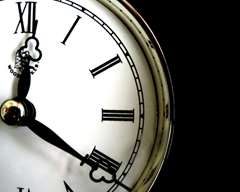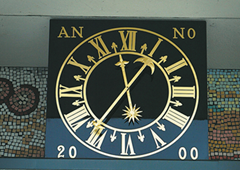Belfast clocks
 Public clocks are an important part of everyday life in Northern Ireland but they also track many events throughout history. Emma Blee talks to horologist Fergus Fitzsimons about their significance.
Public clocks are an important part of everyday life in Northern Ireland but they also track many events throughout history. Emma Blee talks to horologist Fergus Fitzsimons about their significance.
A wide variety of clocks are dotted across the province, from town and church clocks to those on memorials and private businesses.
In the 1880s they were used for time- keeping, meeting points and to mark major historical events.
Local horologist Fergus Fitzsimons says they were vital for those living and working in industrial cities and towns: “Before the railways there were different times throughout Britain. It was only the advent of railways that created the necessity to have what is called standard time otherwise they could never have had timetables.”
The general public couldn’t afford to buy time-pieces or watches, he says, so visiting public clocks was “their only way really to tell the time, except for looking at the sun.”
“Virtually every town had a clock and a lot of manor houses would also have had clocks to let their workers know when they had to come to work. A lot of them struck bells so they could be heard for two or three miles so locals would know it was time to come to work,” comments Fitzsimons.
In Belfast, many private businesses took advantage of the niche market of time- keeping.
Fitzsimons explains that while this would have been a kind gesture there were also benefits for the proprietors who installed the clocks.
“It would have been expensive to put up a clock in those days but it also would have added prestige to their building.
People would have made a habit of visiting certain buildings in order to find out the time.
“It was an early method of advertising but the main thing was to provide the public with accurate time-keeping,” he remarks.
The Albert Memorial Clock was built between 1865 and 1869 in memory of Queen Victoria’s husband Prince Albert, after his death in 1861.
The former Belfast Corporation decided to build the clock tower because there wasn’t much architecture to show to visitors. There was a competition to design the clock and Newry architect William J Barre, who also designed the Ulster Hall, won.
It was erected near where Queen Victoria landed in Belfast in 1849. The clock strikes the hour and quarter hour and has been electrified in the last 15 years, which means that it is now electrically wound instead of manually wound.
“For years it had to be hand-wound and they appointed someone every year to do that. It would have been a big task. You would have had about 140 steps to climb up and down and it had to be changed twice a year,” explains Fitzsimons.
However, the tower was built on marshy land close to the Farset River and began to tilt shortly after it was erected. In 2002, more than £2 million was spent on renovations and new foundations to stop the tilt getting worse.
“The tilt created problems with the clock because once the pendulum is put off the angle it won’t work. That had to be adjusted regularly but now the building has been underpinned and it’s supposed to be stable. It’s leaning but isn’t leaning as much,” says Fitzsimons. The Albert clock was also famous during the 1980s because hundreds of people used to gather to ring in the new year and celebrated by smashing bottles on the tower.
A clock tower at Belfast’s gasworks on the lower Ormeau Road marks the site where the city’s gas-making industry began production in the 19th century. The building’s small tower clock was designed in 1887 by Robert Watt and it was one of the first to be erected in the British Isles. Fitzsimons says that while it doesn’t appear to have changed from the exterior, the clock has been revamped over the years to keep up with the times: “Eight years ago it was completely renovated. The mechanical movement was kept but an electrical winding system was installed. It automatically winds itself every three or four days now.” The landmark clock also adds prestige to the gasworks building: “It made the building more grandiose and it made people look at the building and take note. It would have been looked upon by some as an unnecessary extra expense but it added prestige and people relied on it.” While the clock strikes on the hour, Fitzsimons explains that there may also be other functions. “We have only recently discovered that there is an additional mechanism to it but so far it’s not known what it is for. It is being investigated as to what its purpose was,” he states.
Modelled on Big Ben, the Guildhall building in Derry houses one of the largest clocks in Ireland.
It was built in 1891 by Ritchie’s of Edinburgh which still gives its intricate mechanism a yearly service. It strikes hourly and its Cambridge chime rings out across the city.
The bells were supplied by John Taylor and Co. of Loughborough. The large bell weighs over two tonnes and is struck by a hammer weighing 88lbs. The weight of the clock and bells combined is over 10 tonnes.
The Guildhall was badly damaged by fire in Easter 1908, with only the clock tower surviving. The whole building was rebuilt and renovated after the fire and re-opened in 1912. The clock was later covered up in November 2010 as part of a major restoration, which is due to be completed this year.
Derry City Council engineers are responsible for ensuring the clock is wound twice weekly.
 Fountain Street Clock, Belfast
Fountain Street Clock, Belfast
The Fountain Street Clock in Belfast city centre was built in Germany and then shipped to Northern Ireland.
Built in 2000, it is a radio-controlled clock, which means it receives signals from Frankfurt regularly throughout the day, keeping an accurate account of the time.
“It is an unusual clock because it has different figures associated with different seasons throughout the year. For example, at Christmas it has the nativity scene with figures of King David, John the Baptist, Joseph, Mary and Jesus,” comments Fitzsimons.
The bronze chiming bells are the work of Joachim Otto Buer from Germany who was also commissioned to carve the wooden figures.
The structure was designed by architects Eileen Fitzpatrick and her husband Sam Mays. There are also mosaic pane which shows morning, afternoon and evening. These are the work of artist and sculptor Bernadette Sutton.
On the hour the bells play melodies as the figures emerge and move round the clock. Alice in Wonderland figures also appear at specific times.
 Harbour Commissioners’ Clock, Belfast
Harbour Commissioners’ Clock, Belfast
The Harbour Commissioners’ clock tower was built in 1859 and is designed by board engineer George Smith using Byzantine architecture. Its main function was to regulate sailings.
It is a four-dialled clock and faces down to the harbour and looks north, south, east and west. The clock can be seen all around the harbour and by boats coming in and out.
While it started out as a mechanical clock it has since been electrified. One of its flaws, though, is that it is not illuminated from the inside so it isn’t visible at night-time.
Fitzsimons comments: “It is a grand looking clock and the boats coming up and arriving in Belfast can see this prominent clock ahead of them. It would have been used by the tenders in Belfast Harbour so they could go by the harbour clock right down to when boats arrived and departed. Ships’ logs would have used it as well.” The clock is currently being restored and work is expected to be complete in June.
The McKee Clock sits at the foot of High Street in Bangor’s sunken gardens. It was named after a local rates collector, William McKee, who donated £200 towards its construction in 1915.
One the base of the clock a black granite slab is engraved with the inscription “8 July 1915. This stone records the appreciation of the Bangor Urban District Council for the generous gift of this clock to his native town by James McKee. The above James McKee died on 28th April 1919.”
During World War II the Luftwaffe dropped a bomb on the clock but there was very little damage. While many locals no longer rely on the clock for the time, it remains a popular meeting place in the town.









